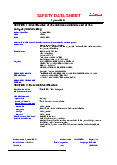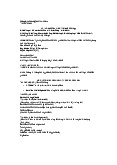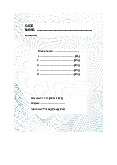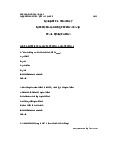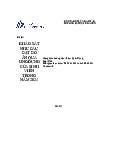




Preview text:
Integrated Marketing Communication Plan Outline
Section 1: Describe the Product/Service featured in your IMC Plan
In the introduction of the IMC plan you will describe what the product or service is that you
will be advertising. Its purpose is to give the background of the product/service and a
description to the reader so that they understand what your proposal is about.The
background part briefly describes your company's history and gives a description of the
product or service you will be marketing. Include features, structure, and other
components of the product or service that are important to the IMC plan.
(See Introduction guidelines on ccsfmarketing.com, Section 1)
Section 2: Brand Image, Logo, Name & Packaging
1. Brand Name- A corporate name is the overall banner under which all other operations
occur. What type of corporate name are your choosing: Explain which type of name
category your product/service falls under and why.
Overt namesreveal what the company does (American Airlines, BMW Motorcycles).
Implied namesimply what the company is about (Federal Express, IBM).
Conceptual namesimply the essence of the brand (Google, Krispy Kreme).
Iconoclastic namesdo not reflect the company's goods or services (Apple, Monster.com).
2. Logo- Quality logos and corporate names should pass four tests, design a logo for your product/service
Draw using colored pencils/pens or on the computer design what your logo will look like. (I
am not grading on artistic ability, but rather effort)
a. What components of your logo make it easily recognizable?
b. What part of your logo makes it familiar to your target market?
c. What consensual meaning among those in the firm’s target market does your logo elicit?
d. What type of positive feelings does your logo convey?
3. Developing a Strong Brand - Developing a strong brand begins with discovering why
consumers buy a brand and why they re-purchase the brand. Answer the following
questions about your brand. Answer the following questions?
a. What are the brand's most compelling benefits?
b. What emotions are elicited by the brand either during or after the purchase?
c. What is the one word that best describes the brand?
d. If your brand were a car, animal, instrument, color, music group... what kind would it be
e. What is important to consumers in the purchase of the product?
4. Packaging- A unique package and label can help sell a product, build brand
recognition, and inspire repeat purchases. Draw and describewhat your packaging will look like.
a. Explain how your package design takes advantage of new trends, including:
- Meet consumer needs for speed, convenience, and portability -
Must be contemporary and striking -
Must be designed for ease of use -
Packages must be eye-catching and contemporary.
5. Labels - Labels must: Meet legal requirements·Point out distinguishing features of the product
·Help lead to the purchase
a. What does your packaging label look like. Draw an example. Section 3: Buyer Behavior
In this section you will describe your target markets buyer behavior.This section will
include the purchase process, a cognitive map, and trends in the buying environment
1.Consumer purchase process–Finding ways to influence the consumer purchasing
process is a vital activity in developing your IMC. Briefly describe each step in the
consumer decision-making process as it relates to your target
a. What problem is your product/service solving
b. What is the recognizable need or want
c. How is the information search conducted (internal/external)
d. How does your consumer evaluate alternatives (evoked set, multiattribute, affect referral
e. What consumer attitudes can be influenced by your IMC
f. What values (strongly held beliefs) about your brand do consumers hold
g. Define the set of personal values and how your IMC plan can integrate that value into creative.
2.Cognitive mapping–The manner in which your target stores information affects
decisions. Knowing how your target stores, retrieves, and evaluates information can help
you develop impactful advertising. Draw a cognitive map to demonstrate your targets
“typical” knowledge structure and memories embedded in their brain.
3.Trends in the consumer buying environment–Studying the steps your target takes
is important in developing the right communication message, creative and mix. At the
same time, the environment in which your consumer purchases your product is always changing.
a. What trends in the consumer buying environment affect purchasing patterns for your product/service
Section 4: IMC Planning Process
In this section, you will describe your target market, product positioning and you campaign
objectives.A careful and thorough description of your target aids in directing your
communication plan. By understanding exactly who you are speaking to, you can better
deliver marketing communications with the right tone, manner in the appropriate media.
1. Target Market–Describe you target market, in detail, using the segmentation
approaches discussed in class.
a. What market segmentation approaches have your selected to develop an Advertising
campaign around:(note: you do not have to use all of these approaches, select the
approaches that make the most sense.) • Demographics• Psychographics•
Generations• Geographic• Geodemographics•
Benefits• Usage
*see the tab labeled Target Market for further detail and sample target descriptions
b. Describe your target market in detail (see Target market (Tab) for examples. After
reading your target description, I should have a clear understanding and picture of who
your product/service is being marketed to. The more detail the better.
c. Using old magazines, internet photos, drawings, etc. Make a collage of your target
market. Make sure the images in your 81/2 x 11 page collage matches your target market description.
2. Positioning– Positioning is the perception created in the consumer’s mind regarding
the nature of the company and its products relative to the competition.
a. Describe what your product/service positioning will be. What do you want to stand for
in the mind of your consumer? Choose from the following and explain why are how?
· Product Attributes· Competitors· Use or application· Price/quality· Product
user· Product class· Cultural symbol
3. Marketing Communications-Most IMC campaigns will emphasize one
communication objective, but may accomplish other objectives in the process. There are
some logical combinations, such as developing brand awareness and building customer
traffic. Increase market share would fit with increase sales and encourage repeat purchase
actions. The key is to match the objective to the medium and the message.
a. What are the maintwocommunication objectives for your IMC campaign? Explain why you choose those objectives.
- Develop brand awareness- Increase category demand- Change customer beliefs and
attitudes- Enhance purchase actions- Encourage repeat purchases- Build customer
traffic- Enhance firm image- Increase market share- Increase sales- Reinforce purchase decisions Section 5: Means End Chain
1. Develop a means-end chain for your product/service.
What personal value will your campaign drive the consumer toward?
Remember: The advertising message contains a MEAN, which drive the consumer to a
desired state, an END.Draw your means-end chain on a piece of paper, or construct on the computer.
Consumer viewing the ad will reach one of the desired personal value
·Comfortable life· Equality· Excitement· Freedom·Fun, exciting life·Happiness·Inner
peace·Mature love·Pleasure·Salvation·Security·Self-fulfillment·Self-respect
· Sense of belonging· Social acceptance·Wisdom
Section 6: Advertising appeal, Message strategy, and Executional framework
1. Define theadvertising appealfor your IMC plan. Why have you selected this
appeal? Why will it be meaningful to your target? How does this appeal highlight your product/service
-Fear –Humor -Sex –Music –Rationality –Emotions -Scarcity
2. Define the Message strategy you will use in your IMC campaign. Describe why
and how this strategy will relate to your product and target audience. Describe how it
integrates with the advertising appeal you have selected
Cognitive (Generic,Preemptive, USP, Hyperbole, Comparative)
Affective (Resonance, emotional)
Conative (Designed to lead to some type of purchase behavior ie. point of purchase display)
3. Describe the type of executional framework you will use for your plan. Explain why
this execution type is the best choice for your product or service.
-Animation -Slice of life -Dramatization -Testimonial -Authoritative -Demonstration - Fantasy -Informative
Section 7: Developing a TV or Social Media Commercial (YouTube)
Using the advertising appeal, message strategy andexceptionalframework defined in
Section 6, develop a detailed television or online campaign that advertises your product or
service. Use the story boardtemplate(or make up your own) to describe your ad. Briefly answer the following...
1. What is the objective of your campaign?
·Increase brand awareness ·Build brand image ·Increase customer traffic · Increase
retailer or wholesaler orders ·Increase inquiries from end-users and channel members · Provide information
2. The Target Audience, Advertising Appeal, Message Strategy, Executional Framework
Summary of your target audience, the advertising appeal that the storyboard will follow,
the message strategy conveyed in the story board, and the executional framework you will be using
3. Complete the Story Boards (available in Section 7: at the bottom of page)
Using the story boards provided, develop a campaign that executes on the above. Get
creative, pull out the colored pencils and write script. The more detail, the better.
4. What Value(s) outlined in your Means-End Analysis does the commercial take the
consumer to. Pull out your Means-End Analysis done earlier.
Section 8: Alternative Media
Develop an alternative marketing program (that integrates into your campaign) for your product/service.
1. Describe your program in detail and how you choose to utilize one (or a few) of the following: Buzz marketing Guerrillamarketing Lifestyle marketing Experiential marketing Product placement Branded Entertainment
Section 9: Consumer Promotion
Enticing consumer to take the final step and make the purchase constitutes a consumer
promotion program. Develop a consumer promotion campaign utilizing one or a few of the
following promotions. Explain what the promotion looks like. How will consumers find the
promotion, how will it be executed, how will the promotion be redeemed. Remember: Details. Coupons - Premiums- Contests & sweepstakes Refunds Sampling Bonus pack Price off. Section 10: PR Campaign
In this section, develop a cause related marketing campaign utilizing PR. What global,
social, health, charity will your company support in order to generate goodwill? Describe this program. - Cause-related Marketing - Green marketing - Pro-environment activities Paper Format: Last Name, First Name
Assignment #_: Title of Assignment MRKT (Class Number) Date
Margins: 1”, Top, Bottom, Left & Right (Page layout Tab/Margins/Normal – 1”)
Spacing 1.5 (Home Tab/Paragraph grouping/Line Space & Paragraph Spacing/1.5)
Font: 12 Point & Times New Roman (Home Tab/Font grouping/Times New Roman/12)
